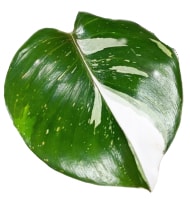Philodendrons are widely popular for their uniquely beautiful foliage. We are introducing another Philo, the Philodendron White Knight. It is a rare variegated tropical, attractive enough to give a classic touch.
The heart-shaped leaves are dark-green with splashes and patches of white. Apart from the leaves, the stems of this Aroid are equally beautiful showing a mixture of colors like brown, deep purple, and white. Sounds cool, right?
Winners for indoor plantation, these South American natives grow equally well outdoors in mild weathers. Thinking about getting one for you? Please go ahead! These low-maintenance plants are suitable enough for everyone including beginners and lazy peeps. Let us dive deeper and learn more about the maintenance and propagation of the White Knight Philodendron Plant.
Philodendron White Knight Classification
Family: Araceae.
Genus: Philodendron.
Cultivar: White Knight.
Genus Philodendron:
This is a vast genus of about 489 flowering plants. These natives of central and Southern rainforests of America form the second-largest Aroid genus. C. Plumier was the first to introduce them in the 16th Century. However, many of the species enjoyed popularity in art, folk culture, and medicine for centuries.
Features of the Philodendron White Knight Plant

Size:
- The length and growth of these plants are highly variable according to space and environment. In open space, a mature plant can get about 3 meters in length.
- These leaves grow at close distance on the stems. This gives a fuller and prettier look to the plant.
Leaves:
- The majority of the plants have heart-shaped leaves. However, some of them may get slightly longer on maturity.
- Each fully-grown leaf is about 6 cm in size.
- The basal colors of the leaves also change with age and sunlight. Expect them to show lighter shades of green especially at the younger stage.
- The shades and variegation on the leaves give it a randomly painted look. This beauty attracts artists for art projects like Paper White Knight Philodendron.
Flower:
- The plants produce typical Aroid flowers in the warm days of spring and summer.
- Long erect spadix covered by expanded spathe forms the inflorescence. Numerous tiny flowers grow on the spadix which is covered by the leaf-like spathe.
Toxicity:
All the Philodendrons contain high levels of calcium oxalate crystals. Ingestion of the foliage leads to an allergic reaction on the lips, mouth, and esophagus. Moreover, they can pose severe effects on animals as well. So, make sure you don’t let kids and pets mingle with these beautiful plants.
White Wizard Philodendron
This is another plant showing a close resemblance with the White Knight. These two are confusingly similar, so it would be better to compare both. Let us have a look at the basic features of the plant to help you differentiate between the two:
- The stems of the White Wizard Philodendron are green unlike the purplish-green and white ones of the Knight.
- The leaves are larger.
- The growth rate of the plant is faster.
- The care and maintenance of the White Wizard are quite similar to the Knight, as mentioned in the next section.
Philodendron White Knight Care
These tropical Aroids are easy-to-grow plants. Just follow the specific guideline and you will see them flourishing without expecting much of your effort.
Quick Guide:
Water: Average. (Water right after the upper soil gets dry)
Sunlight: Bright to medium indirect sunlight.
Humidity: Average.
Fertilizer: Mild doses in spring and summer.
Without any ado, let us learn about the growing requirements in detail;
Water Requirements
The majority of Philodendrons love to stay in moist and well-drained soil. Water the soil moderately and re-water right after the upper layer loses its moisture. Now, let us talk about the watering schedule. It is dependent on features like temperature, humidity, and sunlight. It would be quite helpful if you understand the soil and drying patterns of the soil.
The suitable frequency for warm days varies from once to thrice a week. While about once every two weeks is enough to keep the plant alive on the cold days. Over-watering is quite harmful to the plant. Make sure you avoid it to save the plant from issues like fungus and root rot.
Sunlight Requirements
Medium to bright indirect light is ideal for the plant. The delicate foliage can not withstand direct exposure to sunlight. Moreover, the white variegated parts on the leaves are the most vulnerable ones. In strong light, these are the ones getting scorched out on first.
The beauty of the white Knight foliage enhances with the color variation of the foliage. A plant staying in shade and low light for longer periods may lose the variegation.
Humidity Requirements
The normal humidity level of your zone will be enough for the plant. However, these natives of tropical rainforests grow lush foliage in high humidity.
In dry weather, you can follow any of the measures to maintain the moisture. You can mist the foliage frequently. However, make sure the plant stands in a well-ventilated place and the foliage does not stay wet for long. Using a pebble-water tray or a room humidifier are other possible remedies to combat dryness.
Soil Requirements
Rich and well-draining soil or potting mixtures are ideal for the philodendrons. If you are growing them in pots or containers, you need more than the natural soil. The reason being the garden soil can contain germs, micro-organisms, and weeds. Moreover, it may not allow quick-draining.
Experts recommend using a good quality potting mixture added with a few other ingredients. A mixture of 30 to 50% good quality potting mix with perlite and orchid bark shows good results.
Temperature Requirements
These delicate peeps like to dwell in a moderate climate. An ideal temperature range of 55 to 85 °F is perfect to keep the foliage happy.
The Knights are intolerant towards cold and freezing temperatures. Thus, make sure the plant stats at some warm indoor spot as soon as autumn arrives.
Fertilizer Requirements
These slow-growing peeps would like to get some additional nutrition in the appropriate season. You can use a quality houseplant fertilizer once a month in the growing season. Make sure you use half of the recommended dose for the delicate foliage.
As far as the type of fertilizer is concerned, liquid fertilizers are a nice option for indoor plants. On the other hand, slow-release granular fertilizers are better for small outdoor pots.
Over-fertilizing is harmful. Additionally, it can even burn out and kill the plant.
Pot Requirements
You can grow these plants in pots, containers, and hanging baskets. These creepers need some support like sphagnum moss poles to climb upon. However, you don’t need the support in a hanging basket as the foliage will beautifully cascade down on its own.
Don’t forget to check for drainage holes at the base of the pot to ensure proper drainage.
Pinching Requirements
If the plant looks leggy, you can try pinching. This will help you to give a fuller look to the foliage.
Pruning Requirements
Pruning is good to keep the plant in a good form. Just remove the old and unhealthy leaves to enhance the health and appearance of your Phil plant
Growth Zones
The plants are hardy outdoors in USDA growth zones 9b to 11. Howbeit, for indoor plantation, they are fine in a wide range of zones from 4 to 11.
Philodendron White Knight Propagation
You can make some more of these variegated beauties by methods like;
- Air-layering.
- Leaf or stem cuttings.
It takes a little longer to get a well-grown decorative plant from seeds. On the other hand, air-layering is preferable for experienced growers.
Season
The ideal propagation time starts from the middle of the spring until the middle of the summer.
Propagation by Stem-cutting:
- Take a sharp knife and take a few stem-cuttings, each about 5 to 8 inches in length. Make sure you take at least nodes or he aerial roots.
- Remove the leaves from the lower side and keep a few at the upper end.
- Plant the cutting in the moist well-draining potting mix keeping the aerial roots under the mix.
- Place the pot in a warm place with indirect light.
- Keep misting the soil mildly by spraying with water. Root development starts by the end of the sixth week. Furthermore, you will notice baby shoots growing after six weeks.
Water Propagation:
- Philodendrons are good to grow in water. Just take a jar and fill it with filtered water. If you are using tap water, let it stay uncovered for about 48 hours. This will give ample time for the evaporation of the chlorine.
- Plant the cuttings in water dipping in the nodes.
- You will need to change the water every week to avoid letting the water get mucky.
- Glass jars let you see the root development, which is surely a pleasure. Observing this process with kids is quite educative for them. Wait for about six weeks until you notice the root and shoot development.
- After about two months, you can shift the baby plant to soil or potting mix. Moreover, you can even let it grow in water and your beautiful plant will not mind it at all.
- Please feel free to share your experiments with us and we would love to post it for our readers.
Precautions:
Using gloves is recommended to avoid any kind of negative reaction while handling or propagating the toxic plants.
Related Posts:
Summary
Philodendron White Knight is an evergreen tropical cultivar belonging to the famous Aroid family. In a proper space and suitable environment, this creeper can get about 3 meters long.
Leaves are oval in shape, green in color with patched and splashed variegation in white. Besides, the stems are also uniquely colored displaying shades of white and brownish purple. Pots, containers, hanging baskets and open ground, are suitable enough for both indoor and outdoor plantation.
You can grow these without any panic. Just provide these low-maintenance plants with frequent watering and indirect light. On final notes, these attractive plants are toxic for us and animals. So, make sure kids and pets are staying at a bay from your White Knight Philos.

